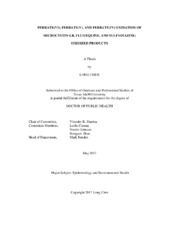| dc.description.abstract | Microcystin (MC-LR) is a potent toxin and its presence in drinking water create a serious risk to human health. This paper presents the degradation of MC-LR in water by iron-based molecules, ferrates (Fe^VIO4^2- , Fe^VO4^3- , and Fe^IVO4^4- ) at pH 7.0. The oxidized products (OPs) were analyzed at various concentrations of ferrate species. Product studies showed the fragmentation of the cyclic MC-LR by all ferrates, which varied with the concentration and the oxidation state of ferrates. Three predominant degradation pathways are proposed, involving hydroxylation and breakage of peptide bond of MCLR. The extent of hydroxylation of MC-LR by Fe^VI was more than by Fe^V and Fe^IV. Fe^VI oxidation has potential to generate OPs with low molecular weight. Additionally, three pH (4.0, 7.0 and 9.0) were investigated to learn their on three pathways of MC-LR by Fe^VI, Fe^V , and Fe^IV. Analysis of peak areas of OPs showed that acidic conditions greatly facilitated the hydroxylation by three ferrates compared with the neutral and basic pH.
Antibiotics have recently attracted increasing concern worldwide due to their ubiquitous occurrence and negative ecological effects on aquatic organisms. This paper investigated the oxidation kinetics and mechanisms of sulfadiazine (SDZ), a representative sulfonamide, by Fe^VI. The results showed that the reaction followed the second-order kinetics, and the rate constants decreased with the increasing pH from 4.0 to 10.0. Eleven OPs of SDZ were identified, and three initial pathways were proposed, including SO2 extrusion, deamination, and hydroxylation, of which the involvement of SO2 extrusion was first demonstrated during FeVI oxidation of SDZ.
In addition, the removal of flumequine (FLU), a representative fluoroquinolone antibiotic, by Fe^VI, Fe^V , and Fe^IV species and the effect of ammonia were studied. The results indicated that Fe^VI exhibited a higher capability for the elimination of FLU than Fe^V and Fe^IV. Furthermore, the presence of ammonia enhanced the removal efficiency of FLU by Fe^VI and Fe^V . The reason was proposed to be the formation of higher reactive Fe^VI -ammonia and Fe^V -ammonia complexes than un-complexed ferrate species. Mechanical analysis indicated that these complexes reacted faster at the double bond moiety of the quinolone ring of FLU. | en |


